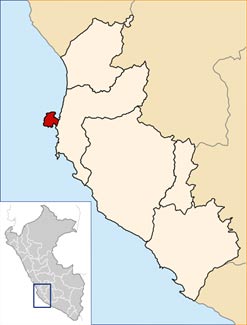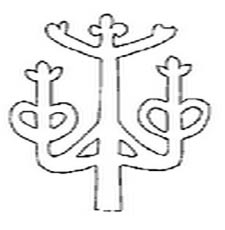
The mysterious prehistoric geoglyph of the Paracas Candelabra
The Paracas Candelabra is a prehistoric geoglyph found in the Paracas Peninsula at Pisco Bay, Peru. It is estimated to date back to 200 BC, although many believe it is much older. With a large, branchlike appearance, the purpose and meaning of the Candelabra remain unknown. There has been much speculation as to the reason it may have been constructed. Was it a godly symbol, a gigantic seismograph, or simply a navigational tool for sailors?

Location of the Paracas Peninsula in the Ica Region of Peru. Image source: Wikipedia
The Paracas Candelabra is estimated to be approximately 595 – 800 feet tall and can be seen from as far as 12 miles out at sea. The geoglyph was created by cutting two feet deep into the hardened soil, with rocks placed around the figure. While scientists cannot be certain regarding the age of the Paracas Candelabra, pottery found in the area was radiocarbon dated to 200 BC. It is believed that the pottery belonged to the Paracas civilization, but it has never been confirmed whether they were responsible for creating the geoglyph.

The Paracas Candelabra was created by cutting two feet deep into the hardened soil. Credit: Javier Dominguez
The shape of the geoglyph is mysterious and somewhat difficult to describe. Some have likened it to a cactus plant, while others believe it looks more like a three-branched candlestick, hence the name “candelabra.” It begins with a single stem at the bottom, which then splits into three smaller branches and each of those separate out again.

An outline of the Paracas Candelabra. Image source.
The meaning and purpose of the Paracas Candelabra are unknown to this day. The Conquistadors supposedly believed the geoglyph represents the Holy Trinity, and took it as a good omen and a sign that they should proceed with their quest to conquer and Christianize the locals, although no clear historical records authenticate this assertion. It has also been said that the Conquistadors found a series of ropes and cords within the branches of the Candelabra, which may have been used in connection with a series of pulleys. Peruvian writer and commentator Beltrán García has been quoted as saying the Candelabra may have been “a gigantic and precise seismograph, able to register telluric waves and seismic shocks coming not only from Peru, but from all over the planet.”
Researcher Tony Morrison looked extensively into the local folklore surrounding the Candelabra, to determine its purpose. He interviewed Duncan Masson, a local Englishman who lived about 130 miles south of the Candelabra. Masson had heard first-hand accounts of the Candelabra from those who lived in the early 19 th century. According to these accounts, the Candelabra was used simply as a signal for sailors. The Paracas coastline has been a stopping point for sailors for many centuries. During times of layover, the sailors would have had plenty of time to carve the Candelabra into the hill.

The Paracas Coastline. Image source: Wikipedia
Some believe the Paracas Candelabra is a representation of a hallucinogenic plant called Jimson weed. It has been suggested the prehistoric inhabitants of the Paracas region would travel to what is now California to gather Jimson weed, which provided a hallucinogenic effect when smoked or steeped in water. The Candelabra then helped them to find their way home.

One theory suggests the Paracas Candelabra represents the Jimson weed. Image source.
Others have suggested that the geoglyph represents a lightning rod of the god Viracocha, who was the great creator god in the pre-Inca and Inca mythology in the Andes region of South America. According to mythological records, Viracocha rose from Lake Titicaca and brought forth light during times of darkness. He created the sun, moon, stars, and man. He disappeared across the Pacific Ocean, but would return during times of trouble. Creating the Candelabra as a symbol of Viracocha may have been an attempt to guide him towards the people of the Paracas to ensure he would help them during times of trouble.

Viracocha, god of sun and storms. Image source: Wikipedia
The true meaning and purpose of the Paracas Candelabra remain elusive to this day, and may be forever lost to history. Nevertheless, the enormous geoglyph continues to attract people from all over the world who marvel at its sheer size and wonder about its origin and creation.
Featured image: The Paracas Candelabra. Image source: Wikipedia
Sources:
Paracas Candelabra – Strange Journey. Available from: http://strangejourney.tripod.com/paracas.htm
The Paracas Candelabra – Bad Archaeology. Available from: http://www.badarchaeology.com/?page_id=428
The Candelabra of the Andes – Hows.org.uk. Available from: http://www.hows.org.uk/personal/hillfigs/foreign/cand/candel.htm
The Paracas Candelabra – Wikipedia. Available from: http://en.wikipedia.org/wiki/Paracas_Candelabra
Paracas Candelabra – MNM.com. Available from: http://www.mnn.com/lifestyle/arts-culture/photos/10-mysterious-geoglyphs-around-the-globe/paracas-candelabra
Viracocha – Wikipedia. Available from: http://en.wikipedia.org/wiki/Viracocha
By M R Reese
















Comments
This is a Peratt plasmoid shape, it is the cosmic thunderbolt or trident, found commonly in many cultures. You can download Peratt's groundbreaking paper online and see the plasmoid shapes produced for yourself.
Seems an awful lot of work for a simple navigational device. Seems a more simplified design would have done as well. I too, believe the design is older than the pot shards around it.. No I do not know its meaning. But I suspect it was accomplished by an older civilization. Such huge pictograms have been found worldwide and none have been properly dated.
BI believe it to be a trident especially if it's close to the water
At first glance it looks almost like a menorah. Obviously it is not but....strange anyway.
Poseidon's trident?
Pages